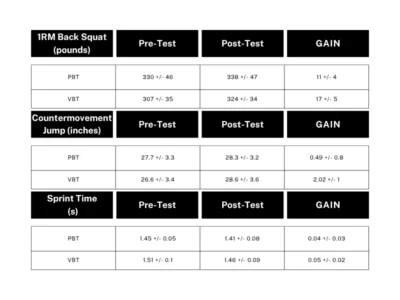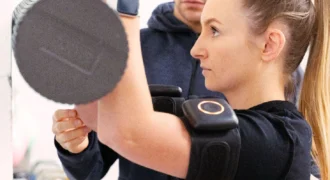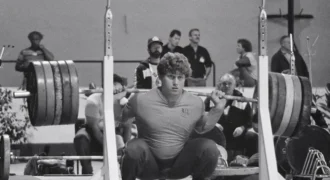Introduction
I recently completed my dissertation for the Ph.D. program at Liberty University. The intent behind this project was to investigate the use of traditional training methods relative to a velocity-based protocol. This project was the first of its kind to investigate the connection between these two training methods in the high school team setting. Since publication, I’ve received several follow-up questions related to the methods and science behind ‘why’ it worked. I’ve also received a few messages about the document’s length, and trust me, I don’t blame you for not wanting to read it. However, the information from the project holds implications for us as coaches and may also serve as a resource for additional funding to those of us in the scholastic setting. For those reasons, I wanted to provide a summary of the article that discusses the findings and theoretical reasoning behind the results in a more concise and reader-friendly version.
Background
Strength and conditioning (S&C) is critical to the development of athletic qualities, especially when working with youth or adolescent populations. This is especially true in American football, where the physical demands of the sport favor physical qualities related to strength, power, and rate of force development. In high school S&C, coaches are constantly seeking methods that not only improve performance but also effectively manage training load and fatigue. In this context, two methods of resistance training are commonly used: Percent-Based Training (PBT) and Velocity-Based Training (VBT).
Percent-Based Training is a traditional approach in which athletes lift weights based on a percentage of their one-repetition maximum (1RM). For example, a coach may prescribe three sets of five reps at 75% of an athlete’s 1RM. This method is grounded in established principles of exercise science and has long been the standard in high school weight rooms. In contrast, Velocity-Based Training uses various forms of technology to quantify movement characteristics. Instead of prescribing weight by percentage, VBT adjusts the load based on how fast the barbell is moving during the lift. This method measures bar speed in real time, allowing training loads to be tailored to the athlete’s readiness and performance each day.
Video: Athletes performing the bench press with weights and reps programmed by Enode VBT
Methods
To understand how these two methods compare, a study was conducted involving 19 high school football players with an average age of 16 years. These athletes had already completed at least one semester of structured weight training, ensuring they were familiar with proper lifting techniques. The athletes were divided into two groups. Over the course of a 6-week training cycle, one group followed a traditional PBT protocol, while the other used VBT methods with Enode. Both groups trained with similar exercises and set/rep schemes, but the loading strategy varied based on group assignment.
Performance improvements were assessed through three key metrics: 1RM back squat (strength), countermovement jump or CMJ (power), and 10-yard sprint time (speed). In addition, total time under tension (TUT)—how long muscles were under strain during each repetition—was tracked for both groups. These performance metrics are known as Key Performance Indicators (KPIs) in strength and conditioning. These are reliable indicators of an athlete’s performance qualities.
Results
At the end of the six-week training period, both groups showed significant improvements across all metrics. However, the VBT group demonstrated significantly greater improvements in back squat strength and jump height. There was no meaningful difference between the groups in sprint performance. Perhaps most notably, the VBT group achieved these improvements while spending significantly less time under tension. In practical terms, they got stronger and improved their jumps with less time under the bar and implied stress.
The VBT group achieved these improvements while spending significantly less time under tension. In practical terms, they got stronger and improved their jumps with less time under the bar and implied stress, says @CoachMullinsPhD
Share on X
Tables 1 and 2 below show the difference in performance improvement for all measurables. One point of emphasis is the improvements seen in linear sprints. This study used a 10m fly with a 5m lead in to measure sprint times. Both groups experienced statistically significant growth, but neither group out-performed the others in pre-post test growth. The point here is that the differences did not rise to statistical significance for academia, however, practically speaking the VBT group did experience marginally better improvement averaging 0.01 greater sprint time reduction over the PBT group. As a coach, a method producing a 0.01 greater improvement to 10m fly times in 6 weeks is a method I would consider adopting.

Table 1: Pre/Post/Growth for PBT and VBT groups in the back squat, countermovement jump, and linear sprint.

Table 2: Total Time Under Tension in the squat for both groups throughout the 6-week intervention cycle.
Discussion
So, why does VBT work? One of the core principles behind VBT is ‘training with intent.’ When athletes are told to lift a weight as fast as possible—and are given real-time feedback on how fast they’re moving—it increases motor unit recruitment. In particular, high-threshold motor units, which are responsible for explosive movements like sprinting and jumping, are recruited more efficiently. This leads to improvements in strength and power, even if total training volume is reduced.
When athletes are told to lift a weight as fast as possible—and are given real-time feedback on how fast they’re moving—it increases motor unit recruitment. In particular, high-threshold motor units, says @CoachMullinsPhD
Share on X
Specifically adding a tangible threshold such as a velocity target gives athletes a goal to push for. In math or science class a research-backed feedback loop includes: giving a student a target, assessing their performance toward that target, providing feedback, and reassessing their growth following intervention. This learning process is no different in the PE class or weight room. The average high school athlete doesn’t know how to move the bar with intent, nor do they understand what a “fast” rep looks and feels like. Further compounding the issue, a low training age with little experience to draw from reduces an individual’s understanding of how a fast 60% feels relative to a fast 80-90% rep. We’ve all had those athletes who perceive a rep as “easy” or “smooth” but when they add 5 or 10 pounds. to the bar somehow it feels as if they forgot how to squat.
The sooner we can teach an athlete how to move with intent under the bar, the sooner we can maximize the neuromuscular response to training. Specifically speaking relative to our athletes, the most significant secondary benefits of training with intent include improvements in rate coding, motor unit synchronization, and more efficiency in the stretch-shortening cycle. Introducing students to VBT principles provides the athlete with objective feedback to improve their movement literacy and builds a more efficient neuromuscular highway.
Linking Neuromuscular and Performance Gains
These improvements are not without external, performance links as well. As mentioned previously, participants in the VBT protocol improved their back squat and jump height more significantly than participants in the PBT group. When we specifically look at the analysis of the squat, the PBT group improved their 1RM by an average of 11 pounds. in 6 weeks while the VBT group experienced an average of 17 pounds. in 6 weeks. What compounds these results further is if we look at these results from an individual basis. Not only did the VBT group improve by a greater average, every participant improved by a minimum of 10 pounds. with two participants improving by 20-25 pounds. in just 6 weeks. However, in the PBT group, one athlete showed no improvement, several with 5 pound increases and one athlete with a 25 pound increase on his back squat. Some may read these statistics and think, “both groups produced a 25 pound improvement for one athlete, so the potential to improve is there with and without the technology.” Sure, the ability to improve is present without technology, such has been the case for decades in the S&C world. However, what I find astounding in this analysis is the fact that the VBT group works for every participant. Every participant improved at least 10 pounds. As practitioners, we will all have a high number of athletes who will improve regardless of the methods we choose. But not many methods can say that they work for everyone. Regardless of whether this group level growth came from the added layer of knowing their performance dictated the load of the next set or the increased accountability to “how” the set was completed rather than the set simply being completed, our job as coaches is to provide a learning environment that supports all students. Not just the ones who will gain 25 pounds. to their squat.
Potentially even more shocking than the squat improvements were the improvements to the countermovement jump. The group using traditional methods expressed an improvement of 0.48 inches in 6 weeks while the VBT group added 2.02 inches in the same timeframe. My thoughts on this aspect of the findings stem from a collection of ideas. On one hand, the improved nature of intent as previously discussed may elicit a greater neuromuscular improvement in terms of efficiency while also increasing the athlete’s force production capabilities as seen in the 1RM squat improvements. Improvements to the neuromuscular system may have contributed greater rate coding and rate of force development factors which impacted the VBT group’s performance. The improvement may also be partially impacted by the improvements in the squat itself. Improving the magnitude of lower body force production and the magnitude of force relative to bodyweight has implications on CMJ height.
Video: Athletes performing a front squat using Enode VBT to prescribe loads
Fatigue Management and Competition
Another key benefit of VBT is its autoregulatory nature. Unlike percent-based programs, which assume the athlete is at peak readiness every training session, VBT adapts to the athlete’s actual performance in real time. If an athlete is fatigued or under-recovered, their bar speed will be lower, and the system will reduce the load accordingly. This protects athletes training in a fatigued state and reduces the risk of injury. Conversely, if an athlete is feeling great, they can push harder that day and take advantage of their readiness.
This autoregulation allows coaches to give athletes the ability to strike when the iron is hot and give them the tools to pull back when needed as well. Recording the sessions through an athlete management system or in the VBT software itself can help coaches monitor athletes and provide warnings as to when conversations need to happen about recovery practices. The current study concluded that the VBT group experienced significantly greater improvement while also experiencing less total volume and time under tension. This reduction in applied training stress can help drive adaptation for longer and produce an athlete who is more resilient by building up the armor. This is said with the caveat that stress is also a needed component for adaptation. Too little stress, no growth. Too much stress however, and we expose our athletes, especially those in the heart of development, to a cascade of potential issues.
VBT also enhances athlete engagement. The immediate feedback provided by velocity tracking devices makes each rep feel like a mini competition. Athletes can see their performance on screen, track progress, and try to beat their previous bests. This competitive aspect creates buy-in and encourages athletes to approach each set with focus and intensity. In a team environment, this can foster a culture of accountability and effort.
Anecdotally, the athletes who participated in the study frequently expressed that they weren’t going to be the one in their group who had to drop weight. What they were expressing was an environmental link to performance. Again, the load for each set was determined by the performance of the prior set. When working in a team environment, that kind group-level accountability and motivation can be a powerful motivator.
Conclusion
From a coaching perspective, VBT provides a powerful tool for managing large groups. High school strength coaches often face the challenge of training dozens of athletes at once, many of whom are at different stages of physical development. VBT can help coaches quickly identify which athletes need to adjust loads, who is fatiguing, and how training is affecting each individual. This level of insight would be difficult to achieve with traditional methods alone.
It’s also worth considering the broader implications for long-term athletic development. VBT supports quality over quantity. Rather than grinding through reps to failure or using an inappropriate load, athletes can focus on moving the bar with technical precision and intent. This aligns with the principles of long-term athletic development (LTAD), which emphasize technical proficiency, neuromuscular coordination, and minimizing unnecessary fatigue during youth training. Especially for high school athletes who are still growing, reducing excessive strain can help prevent overuse injuries and burnout.
The potential benefits of VBT integration are compelling. This study highlights how VBT can be used effectively in a high school football setting. Athletes improved key performance metrics—strength, power, and speed—while experiencing less muscular fatigue. Coaches gained a more dynamic and responsive way to program workouts. And perhaps most importantly, athletes were more engaged and motivated throughout the process.
Moving forward, additional research is needed to evaluate how VBT performs during the in-season period when athletes are juggling practice, games, and recovery. It’s also worth investigating how VBT impacts injury rates, athlete retention, and long-term performance development. As this evidence grows, it can guide future best practices for high school strength programs and support better resource allocation, especially in public education settings where funding is allocated based on research-backed practices.
In conclusion, velocity-based training represents a promising advancement in the science of athletic development. For high school football coaches looking to improve performance while preserving athlete health, VBT offers an efficient, engaging, and evidence-based alternative to traditional percent-based training. With the right tools and guidance, VBT can elevate the training experience and outcomes for the next generation of athletes.
For full article access, click here.
The post Assessing VBT vs Percent-Based Training – Challenging Traditional Training in the High School Setting: A Review of Publication appeared first on SimpliFaster.







